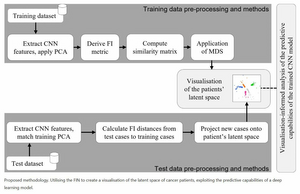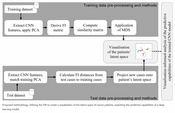Information
- Publication Type: Journal Paper (without talk)
- Workgroup(s)/Project(s):
- Date: August 2022
- DOI: 10.1038/s41598-022-17894-6
- ISSN: 2045-2322
- Journal: Scientific Reports
- Open Access: yes
- Pages: 14
- Volume: 12
- Publisher: Nature Publishing
- Keywords: Breast, Female, Humans, Information Services, Mammography, Breast Neoplasms, Deep Learning
Abstract
Breast cancer is the most commonly diagnosed female malignancy globally, with better survival rates if diagnosed early. Mammography is the gold standard in screening programmes for breast cancer, but despite technological advances, high error rates are still reported. Machine learning techniques, and in particular deep learning (DL), have been successfully used for breast cancer detection and classification. However, the added complexity that makes DL models so successful reduces their ability to explain which features are relevant to the model, or whether the model is biased. The main aim of this study is to propose a novel visualisation to help characterise breast cancer patients using Fisher Information Networks on features extracted from mammograms using a DL model. In the proposed visualisation, patients are mapped out according to their similarities and can be used to study new patients as a 'patient-like-me' approach. When applied to the CBIS-DDSM dataset, it was shown that it is a competitive methodology that can (i) facilitate the analysis and decision-making process in breast cancer diagnosis with the assistance of the FIN visualisations and 'patient-like-me' analysis, and (ii) help improve diagnostic accuracy and reduce overdiagnosis by identifying the most likely diagnosis based on clinical similarities with neighbouring patients.Additional Files and Images
Weblinks
BibTeX
@article{martorell2022,
title = "Breast cancer patient characterisation and visualisation
using deep learning and fisher information networks",
author = "Sandra Ortega-Martorell and Patrick Riley and I Olier and
Renata Raidou and R Casana-Eslava and M Rea and L Shen and
P.J. Lisboa and C Palmieri",
year = "2022",
abstract = "Breast cancer is the most commonly diagnosed female
malignancy globally, with better survival rates if diagnosed
early. Mammography is the gold standard in screening
programmes for breast cancer, but despite technological
advances, high error rates are still reported. Machine
learning techniques, and in particular deep learning (DL),
have been successfully used for breast cancer detection and
classification. However, the added complexity that makes DL
models so successful reduces their ability to explain which
features are relevant to the model, or whether the model is
biased. The main aim of this study is to propose a novel
visualisation to help characterise breast cancer patients
using Fisher Information Networks on features extracted from
mammograms using a DL model. In the proposed visualisation,
patients are mapped out according to their similarities and
can be used to study new patients as a 'patient-like-me'
approach. When applied to the CBIS-DDSM dataset, it was
shown that it is a competitive methodology that can (i)
facilitate the analysis and decision-making process in
breast cancer diagnosis with the assistance of the FIN
visualisations and 'patient-like-me' analysis, and (ii) help
improve diagnostic accuracy and reduce overdiagnosis by
identifying the most likely diagnosis based on clinical
similarities with neighbouring patients.",
month = aug,
doi = "10.1038/s41598-022-17894-6",
issn = "2045-2322",
journal = "Scientific Reports",
pages = "14",
volume = "12",
publisher = "Nature Publishing",
keywords = "Breast, Female, Humans, Information Services, Mammography,
Breast Neoplasms, Deep Learning",
URL = "https://www.cg.tuwien.ac.at/research/publications/2022/martorell2022/",
}


